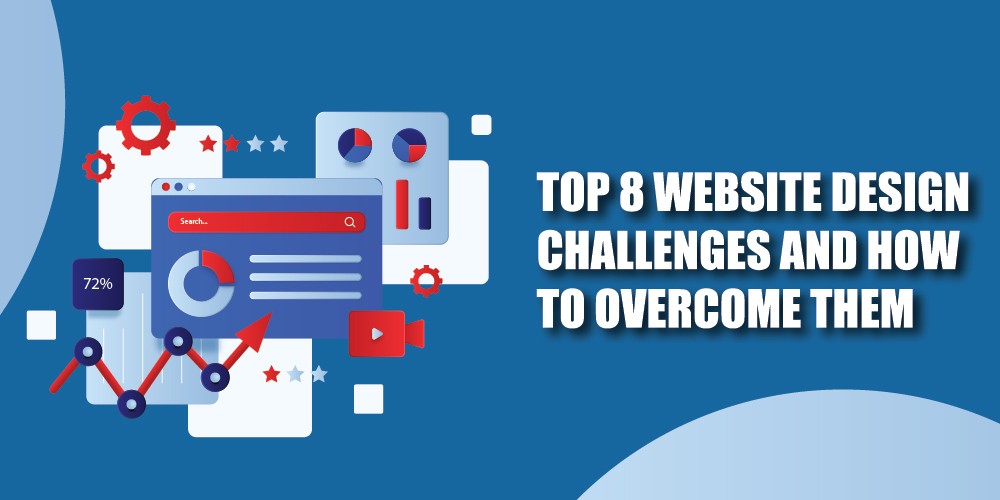The growth of technology and digital innovation has forced companies to change their web design and development approach.
In addition to bringing new business opportunities, there are enormous challenges faced by companies who need to move from legacy applications towards a highly digitized environment.
Thus, companies need to build user-friendly and high-performance websites to meet the growing demand from their smart and digital-savvy customers.
Moreover, web design agencies are faced with more challenges to designing a unique website for every customer that serves as the face of their brand. Business websites should reflect their products and services, allowing them to gain credibility among their prospects and eventually turn them into customers.
The bespoke challenges of contemporary web design and development
According to PWC reports, more than 50% of the companies believe that customer experience and satisfaction are two of the leading factors required for successful digital transformation. There is considerable customer demand for a simple, functional, intuitive, and smooth navigation experience.
Besides the technical requirements, designers must spend time with business owners to ascertain the intended users, the must-have design features, and details of the online experience the business wants to give them when users interact with their website. A website is always designed for its users. Web design agencies need to remember they are serving their own business goals by serving the website’s end-users on a priority basis.
-
User Experience and Interface (UX/UI) and Design
Web design agencies should deliver websites effectively to the deeper needs of all their businesses. The goal here is to become a central part of their users’ day-to-day lives and achieve their business goals by providing pleasure, engagement, and an overall appeal. While a good UX makes a website meaningful, a great UI makes it easy and accessible for the users to work with the website.
Web designers should pay particular attention to see that web site navigation is easy for users, visuals are engaging, and the fonts used are easy to read.
-
Budget consideration of customers
Deciding on the cost can prove to be one of the significant constraints while designing websites for different customers. This might vary based on their business needs and specifications, and most of the time, they might not be able to reach a common agreement in terms of pricing. Both parties must communicate clearly about their expectations to avoid conflict at later stages.
-
Third-party integration
With increasing customer demand for integration of third-party functions, web designers might have to take this factor into account while designing websites. They might be useful for improving site functionality, boost performance, and enhance the companies’ future marketing efforts. Besides, third-party integration may help improve customer engagement and increase conversion rates, which in turn can result in high search engine rankings for your business.
-
Adaptability to different devices
Successful websites adopt a user-centric approach by focusing on meeting the needs of their customers. The focus is on providing engaging content with a better navigation experience across all devices, including smartphones, desktops, and tablets. Web designers need to pay attention to ensure that the site loads faster, provides a flawless user experience, and is easily accessible to the users on various devices. Especially, ecommerce companies need to ensure that their site offers the right information to their shoppers while providing a smooth checkout experience to their customers across different devices.
-
Performance and Speed
When designing and implementing a commercial website, careful thought needs to be put to rule out slow website loading times as they can have real consequences for the business. Businesses only get a single chance to enlist a user on their product. Users will not wait and will leave if the application is slow.
Some future-proofing and planning is necessary when designing websites to ensure the initial website launch can deliver the kind of speed and performance businesses want for their early, often-critical, users but will also provide the foundation they need for future business growth.
The challenging part here is not making sure the application does not slow down if it makes a splash in the market or sees periodic surges in traffic.
-
Scalability & Extensibility
Businesses wanting to get their websites built right today will need to know as much as possible about what they need it to do in the future. Here lies the challenge for website designers to understand how businesses want their applications to develop over time.
Websites need to be extensible, i.e., should be initially designed to incorporate new capabilities and functionality in the future. Planning for scalability and extensibility helps website makers manage different user types, handle increased traffic and overall, improve user experience, fulfill business goals, and extend the application’s lifespan.
-
Protecting personal information
There are several things to be taken care of by website developers to secure their applications and end-users. They must ensure that the infrastructure they build on has enough security services and options so website developers can implement the proper security measures for their application.
SSL certificates for websites are a global standard security technology these days. SSL enables encrypted communication between the web browser and server. When integrated into a web app with HTTPS protocol, they enhance its security and eliminate the chance of it being flagged as unsecure by web browsers.
SSL certificates also help protect credit-card numbers in ecommerce transactions and other sensitive user information like usernames, passwords, and email addresses. This will mitigate phishing attacks on websites wherein malicious users will steal personal user information by prompting genuine customers to click a malicious link by pretending to be a trusted contact of that user.
-
Choose website building platforms
There are plenty of website builders available in the market today that allow web designers to design the website from scratch. They can be time-saving and efficient in creating your site with ease and convenience, without having to rely on manual code. Most of these website builders provide templates and enable web designers to design websites based on their customers’ custom specifications to reflect their business brand and identity.
Conclusion
There are plenty of challenges while designing a website, but the key to successful website building lies in strategic planning while keeping the broader business objectives in mind. Web designers need to integrate design and technical elements and have customer requirements as the key focus in website design and development.




